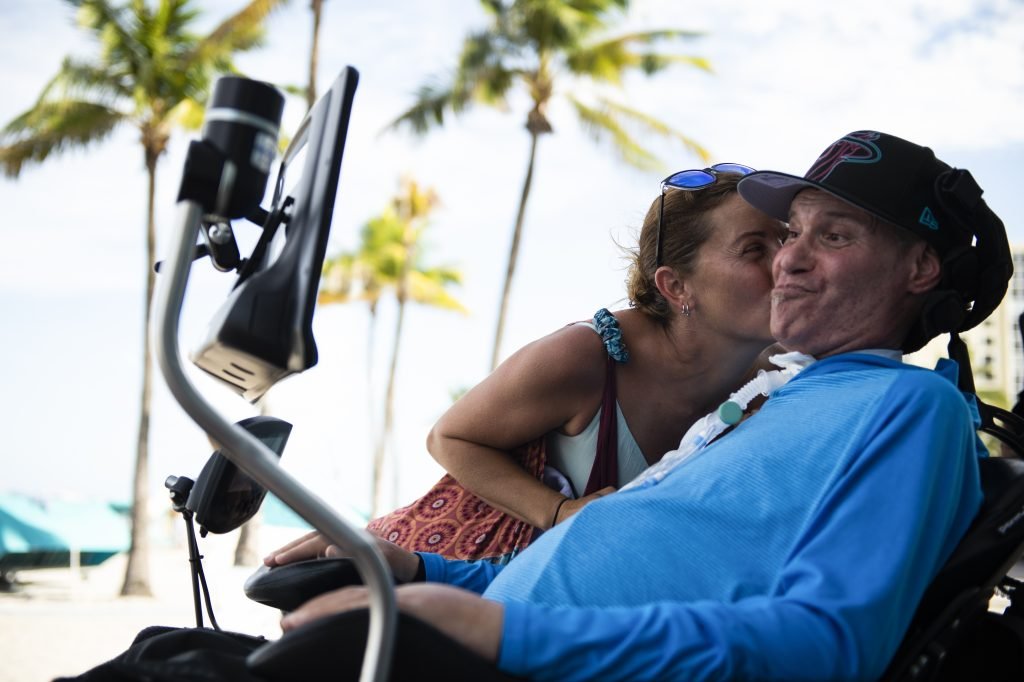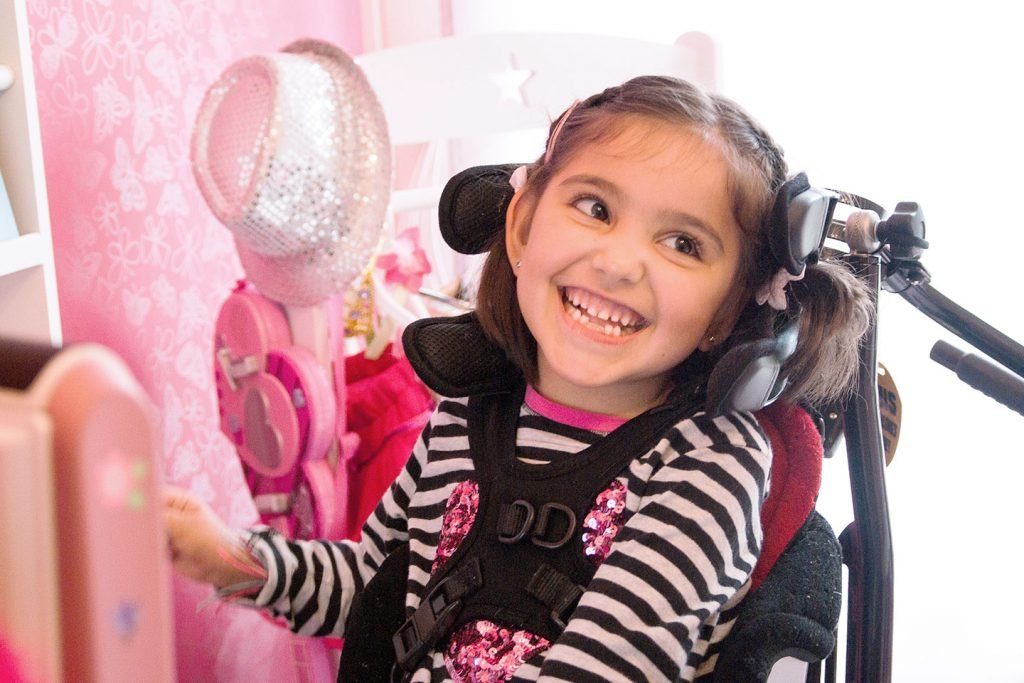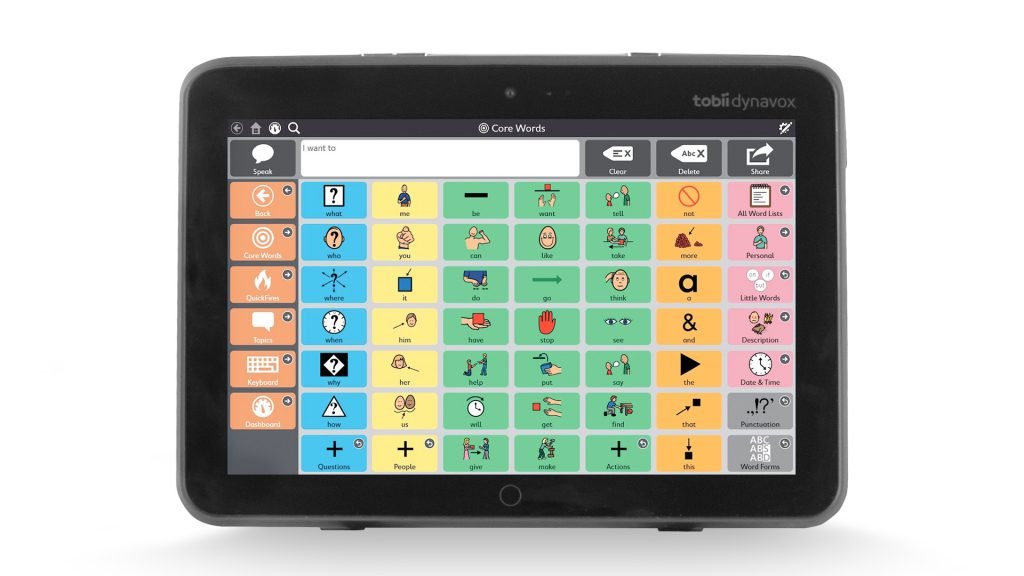Myth:
Assisted communication is a "magic wand" that solves all communication difficulties
Every now and then we hear or read stories about how assisted communication (hereafter PK) can completely change someone's life. Some of these stories are based on research results that confirm that PK:
- Increases the individual's ability to communicate effectively.
- It encourages the use of natural speech;
- Facilitates language and literacy development;
- It encourages the establishment and maintenance of social relationships.
Also, in the success stories we hear from PK users, their families, caregivers and others, it is emphasized that it has opened many doors:
- For the first time after the stroke, Ivan was able to tell his wife that she was beautiful;
- Helena makes friends with people her own age;
- Renato can once again tell stories about his family and life;
- Luka gave a speech to his support group about his life and assisted communication to help others feel better.

Photo by Tobii Dynavox
It is especially exciting when we notice abilities in individuals that we did not know about before. One such example is Julia Tavalaro, born in the USA, who lived in a home for people with severe disabilities after suffering two strokes, after which she could no longer speak or move. Despite the fact that she understood everything that was happening around her, Julija could not communicate with others in any way for six years. Then a speech therapist asked her if she could blink. She could. Then she asked her if she could look up. She could. The speech therapist started reciting the alphabet and asked Julia to look up when she said the letters of her name. Julija managed to spell her name by blinking.Until that day, no one believed that Julia was aware of her surroundings, let alone that she understood others. After a few years, Julija wrote an autobiography (Tavalaro and Tayson, 1998), started writing poems and advocated for a transfer to a better care facility. Without access to this simple form of PK, Julia's life would probably be much different.
Due to the benefits provided by PK, as shown by contemporary research and personal success stories, it may seem that PK is a "magic wand" that can solve all communication difficulties. These stories, however, do not necessarily show how long the journey has actually been. to successful communication These reports often do not address the support of communication partners that is needed, nor how communication is still gradually expanding to other environments.
Challenges in using PK
Introducing PK is almost never a matter of simply placing the device in front of the user and listening to what they have to say. Problems and challenges such as:
- Initial acceptance and use of PK by people with complex communication needs and/or those who help them;
- Development of skills of users and communication partners in the use of PK;
- Limitations of the PK tool itself.
Initial acceptance and use of PK
In order for PK to be used successfully, it should not be accepted only by a person with complex communication needs. It is often a mutual effort here. Communication partners (especially frequent communication partners) must also accept it. Otherwise, it is much less likely that it will be used (Lasker and Bedrosian, 2001). Communication partners who accept PK as a functional and effective way of communication are more likely to respond to PK users' attempts to communicate and will make sure that the communication system is available and ready for use.

Photo by Tobii Dynavox
For some users of PK and their communication partners, acceptance of PK does not present any problem. This group believes that PK is a valuable and useful method of communication by which the user remains connected to the world and people around him. In their research, Ball et al. (2004) showed that 96% of people with amyotrophic lateral sclerosis (ALS) accepted PK because it helped them with communication, community involvement and job retention. Fager et al. (2006) reported that 24 of 25 adults with traumatic brain injury accepted recommended low-tech or high-tech means of PK. If we analyze the percentage of high-tech aids, 94% of adult respondents accepted the recommendations of their speech therapists.
This high acceptance rate doesn't always happen. Some PK users and their communication partners have a lot of difficulty with initial acceptance for a number of reasons:
- Fear that the person will not speak due to the use of PK. This is a common assumption, but for which there is no evidence;
- The person is not used to using new technologies , i.e. it is necessary to invest more effort in developing competencies for using technologies that the person has not encountered so far;
- Reduced cognitive skills. Of all ALS patients, PK was rejected only by those who also suffered from cognitive difficulties (Ball and Beukelman, 2004);
- Expectations regarding speech recovery. Some people with traumatic brain injury refuse to use PK in the belief that their communication difficulties are not long-term (Fager et al., 2006). Some individuals with aphasia, or their family members, feel that they must weigh the "relative value of assisted communication" versus "speech alone" (Lasker, Garrett, & Fox, 2007).
Even when PK is initially accepted, there is still the possibility of withdrawing from it. Bailey (2006) states that giving up PK can occur when "the family's opinion is not taken into account when deciding on assisted communication." Acceptance and long-term use of PK is much easier when the family sees that their goals and priorities for the user will be achieved.

Photo by Tobii Dynavox
Dropouts may also occur due to discomfort with the use of PK, as a result of poor or limited education. PK users, as well as family members and caregivers, should be educated on how to operate the communication device (eg turning on, adding/changing messages) and how to facilitate the use of the PK in daily activities.
Another reason for giving up is the lack of support from the communication partner. In a 2006 study, Fager et al. state that the two people who stopped using their communication device did so because they did not have the constant support of an aide. Partner support may include help setting up and setting up the device, as well as support in learning how to use it. It should be noted here that communication partner support can be lacking for many reasons, including lack of training, frustration, and physical and emotional/mental overload.
Finally, dropout may occur simply because the communication device has not eliminated all communication difficulties. For example, a person with aphasia may still have difficulty constructing grammatically correct sentences, even though overall communication has improved with the use of aids. A person with apraxia of speech may try to use speech more often after receiving a communication device, but it may happen that no change in the quality (intelligibility) of speech is noticed. We must be aware of the fact that the diagnosis has a lasting effect on the overall communication of the individual and his use of PK.
Therefore, as we have already stated, rejection may occur due to fear and insufficient knowledge; persistent difficulties can lead to giving up. We should be aware of this and try to avoid or overcome these difficulties as soon as possible. The following approach could help reduce user churn from PK.
The question may be asked, "What are people with acquired neurological conditions being asked to accept?" Are they being asked to accept a better communication tool or are they being asked to accept that their speech is no longer adequate for their needs?” (Weissling and Prentice, 2010).
Most people with acquired neurological conditions (as a result of stroke, brain injury, ALS, etc.) primarily use PK to replace their speech when it "fails" (Fager et al., 2006). If PK is approached as a of several communication tools that can be used as an aid to, but not a substitute for, speech could significantly increase initial acceptance and decrease dropout from PK use.

Photo by Tobii Dynavox
Developing the skills of using PK in individuals and their communication partners
It is an exception, not a rule, that a person will start functional communication when we place a PK aid in front of them. Much more often, individuals will be able to find some words, communicate motivational messages and perhaps turn the device on and off. They probably won't use it as often and with the level of competence that we would like.
The knowledge and skills required for the competent use of PK can be grouped into four areas of communicative competence (Light, 1989):
- Linguistic – understanding and production of language using appropriate vocabulary and sentence structure;
- Operational – "technical skills to operate the system", including switching on and off, charging, transport and programming;
- Social - skills such as starting, conducting and concluding conversations; production of various communicative functions (eg requesting, commenting, asking questions); and communicating for different purposes, such as expressing wishes and needs, sharing information, developing relationships and being kind;
- Strategic – preventing and/or correcting interruptions in communication, working with the limitations of PK tools.
From a review of these areas, it is clear why PK is rarely used automatically. These competencies are not innate to anyone. Fortunately, communication skills can be learned. There are two important aspects of teaching these skills:
- Assisted partner input , a strategy where the communication partners themselves use the PK system;
- Continuous therapy and training (e.g. with the help of a speech therapist) for the user as well as the communication partner.
As you target communication competence, always use each individual's strengths, understand their weaknesses, and establish realistic expectations for progress.

Photo by Campaign Creators on Unsplash
Restrictions related to PK devices themselves.
Realistic expectations are not just about the PK user and his or her skills. Also, we need to establish appropriate expectations regarding PK itself . The PK system also has some weaknesses, including slower communication, synthesized voice, and dictionary availability (McCoy and Bedrosian, 2001). However, we can use some strategies and device characteristics to try to solve and sometimes overcome these limitations.
We know that communication with the help of PK is slower than speech communication. That's just the way it is. However, many devices offer speed boosts to make communication faster, whether it's taking fewer steps to compose a message, or using prediction using letters, words, phrases or sentences. However, we must take into account physical or visual difficulties that could affect the speed of communication, even if acceleration functions are used.
Although the quality of the synthesized speech of high-tech PK devices has improved dramatically over the years, and is still improving with stronger intonation and emotion options, they are still computerized voices and still do not offer the flexibility of the human voice . Devices that, in addition to synthesized speech, offer the possibility of recording speech could be a solution to this limitation, at least for some messages.
Finally, both low-tech and high-tech aids can be limited by available vocabulary . For individuals who are literate and can type efficiently enough, this may not be a problem. They will be able to type any word they want to say, even if it takes a little longer. Those who can't type will have more problems, because those who adjust the device can't possibly predict all the words and phrases that a PK user might need. Of course, the available vocabulary can be subsequently expanded, so that, for example, if necessary, the communication partner enters new terms into the communicator.

Photo by Tobii Dynavox
These PK device limitations are not insurmountable. We can teach strategies and use different functions of the device to overcome them. However, we must keep in mind that this may affect the use of PK.
Realistic results of using PK
- PK supports and encourages the development of individual strengths in areas such as personality (eg desire for social interaction), characteristics of their diagnosis (eg recall of past events) and age (eg awareness of roles in the community);
- PK can have a positive effect on areas where users have difficulties , but this does not necessarily mean that these problems will disappear;
- The skills and attitudes of communication partners can positively or negatively influence the use of PK;
- Competent communication using PK tools requires linguistic, operational, social and strategic skills that are acquired at different paces ;
- PK should be part of a multimodal communication system* in which communication methods are used independently or combined with each other, depending on the communication environment and the partner;
- PK can help individuals with serious communication difficulties to participate more fully in desired social roles .
As a conclusion, Romski and Sevcik (2005) claim that assisted communication is "simply a tool, a means to achieve a goal - language and communication skills - and not an end in itself." Aided communication cannot answer all communication difficulties, but it can certainly have significant impact on the capabilities and skills of the person using it.

Photo by Tobii Dynavox
*Definition: Multimodal communication system refers to different forms of communication that individuals use for different purposes and in different situations. People who can speak use multimodal communication when communicating. We combine speech with pointing, gesturing, facial expressions, etc. A multimodal communication system can include any combination of speech, vocalizations, facial expressions, body language, pointing, gestures, signs, and low-tech and high-tech means of assisted communication. In the community of users of assisted communication, the prevailing opinion is that multimodal communication systems should be encouraged among users (ASHA, 1991; Blischak and Lloyd, 1996; Loncke et al., 1996; Romski and Sevcik, 2005).
Literature:
AAC definition. In University of Nebraska-Lincoln Augmentative & Alternative Communication Centers. Retrieved January 18, 2010, from http://aac.unl.edu/
American Speech-Language-Hearing Association (1991). Report: Augmentative and Alternative Communication , ASHA, 33 (5), 9-12.
Bailey, R., Parette, H. Jr., Stoner, J., Angell, M., and Carroll, K. (2006). Family members' perceptions of augmentative and alternative communication device use. Language Speech & Hearing in the Schools. 37 (1), 50-60.
Ball, LJ, Beukelman, DR and Pattee, GL (2004). Acceptance of augmentative and alternative communication technology by persons with Amyotrophic Lateral Sclerosis. Augmentative and Alternative Communication , 20(2), 113-122.
Blischak, D. and Lloyd, L. (1996) Multimodal augmentative and alternative communication: Case Study. Augmentative and Alternative Communication , 12 (1), 37-46.
Fager, S., Hux, K., Beukelman, DR and Karantounis, R. (2006). Augmentative and alternative communication use and acceptance by adults with traumatic brain injury. Augmentative and Alternative Communication , 22 (1), 37-47.
Garrett, KL and Lasker, JP (2005). Adults with severe aphasia. In DR Beukelman and P. Mirenda, Augmentative & AlternativeCommunication (3). Baltimore, MD: Paul H. Brookes Publishing Co. 163-206.
Lasker, JP, Garrett, KL and Fox, LE (2007). Severe aphasia. In DR Beukelman, KL Garrett and KM Yorkston, Augmentative communication strategies for adults with acute or chronic medical conditions. Baltimore, MD: Paul H. Brookes. 163-206.
Lasker, JP and Bedrosian, JL (2001). Promoting acceptance of augmentative and alternative communication by adults with acquired communication disorders, Augmentative and Alternative Communication , 17 (3), 141-153.
Light, J. (1989). Toward a definition of communicative competence for individuals using augmentative and alternative communication systems. Augmentative and Alternative Communication , 5 (2), 137-144.
Loncke, F., Campbell, J., England, A. and Haley, T. (2006). Multimodality: A basis for augmentative and alternative communication psycholinguistic, cognitive, and clinical/educational aspects. Disability and Rehabilitation. 28 (3), 169-174.
Romski, M. and Sevcik, R. (2005) Augmentative communication and early intervention: Myths and realities. Infants and Young Children , 18(3), 174-185.
Tavalaro, J. and Tayson, R. (1998). Look up for yes. New York: Penguin.

